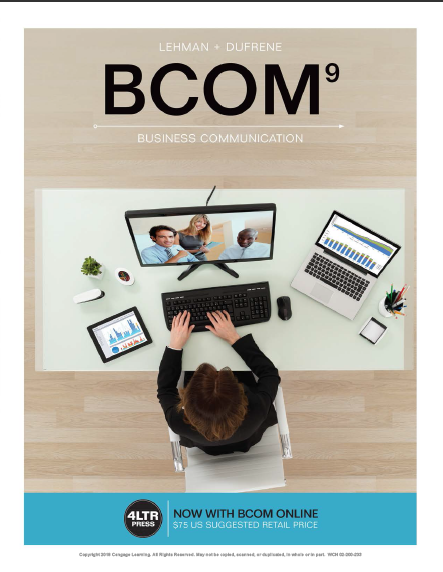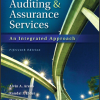Solution Manual for BCOM Bussiness Communication 9th Edition Carol Debbie 9798214338132
$70.00 Original price was: $70.00.$35.00Current price is: $35.00.
Instant download (Solution Manual) BCOM 9th Edition after payment
Solution Manual for BCOM Bussiness Communication 9th Edition Carol M. Lehman, Debbie D. DuFrene – Ebook PDF Instand Download/DeliveryISBN: 9798214338132
Full dowload BCOM Bussiness Communication 9th Edition after payment

Product details:
ISBN-13 : 9798214338132
Author: Carol M. Lehman, Debbie D. DuFrene
Learn Business Communication course YOUR Way with BCOM! BCOM’s easy-reference, paperback textbook presents course content through visually-engaging chapters as well as Chapter Review Cards that consolidate the best review material into a ready-made study tool.
BCOM 9th Bussiness Communication Table of contents:
Chapter 1. Establishing a Framework for Business Communication
1-1. Value of Communication
1-2. The Communication Process
1-3. Communicating within Organizations
1-3a. Communication Flow in Organizations
1-3b. Levels of Communication
1-4. Contextual Forces Influencing Business Communication
1-4a. Legal and Ethical Constraints
1-4b. Diversity Challenges
1-4c. Changing Technology
1-4d. Team Environment
Chapter 1. Learning Objectives / Key Terms
Section Content
Chapter 2. Focusing on Interpersonal and Group Communication
2-1. Behavioral Theories That Impact Communication
2-1a. Recognizing Human Needs
2-1b. Stroking
2-1c. Exploring the Johari Window
2-1d. Contrasting Management Styles
2-2. Nonverbal Communication
2-2a. Metacommunication
2-2b. Kinesic Messages
2-2c. Understanding Nonverbal Messages
2-3. Listening as a Communication Skill
2-3a. Listening for a Specific Purpose
2-3b. Bad Listening Habits
2-4. Group Communication
2-4a. Increasing Focus on Groups
2-4b. Characteristics of Effective Groups
2-4c. Group Roles
2-4d. From Groups to Teams
2-5. Meeting Management
2-5a. Face-to-Face Meetings
2-5b. Electronic Meetings
2-5c. Suggestions for Effective Meetings
Chapter 2. Learning Objectives / Key Terms
Section Content
Chapter 3. Planning and Decision Making
3-1. Step 1: Consider the Applicable Contextual Forces
3-1a. Organizational Culture
3-1b. Dimensions of Context
3-2. Step 2: Determine the Purpose, and Select an Appropriate Channel and Medium
3-2a. Selecting the Channel and Medium
3-3. Step 3: Envision the Audience
3-4. Step 4: Adapt the Message to the Audience’s Needs and Concerns
3-4a. Focus on the Audience’s Point of View
3-4b. Communicate Ethically and Responsibly
3-5. Step 5: Organize the Message
3-5a. Outline to Benefit the Sender and the Audience
3-5b. Sequence Ideas to Achieve Desired Goals
Chapter 3. Learning Objectives / Key Terms
Section Content
Chapter 4. Preparing Written Messages
4-1. Effective Introductions, Coherent Paragraphs, and Powerful Sentences
4.1a. Select the Type of Introduction
4-1b. Develop Coherent Paragraphs
4-1c. Craft Powerful Sentences
4-1d. Select the Appropriate Conclusion
4-2. Revise to Grab Your Audience’s Attention
4-2a. Cultivate a Frame of Mind for Effective Revising and Proofreading
4-2b. Apply Visual Enhancements to Improve Readability
4-3. Improve Readability
4-3a. Improve Readability
4-3b. Eliminate Outdated Expressions
4-3c. Curb Clichés
4-3d. Eliminate Profanity
4-3e. Use Simple, Informal Words
4-3f. Communicate Concisely
4-3g. Project a Positive, Tactful Tone
4-3h. Use Euphemisms Cautiously
4-3i. Avoid Condescending or Demeaning Expressions
4-3j. Use Connotative Tone Cautiously
4-3k. Use Specific Language Appropriately
4-3l. Use Bias-Free Language
4-4. Proofread and Revise
Chapter 4. Learning Objectives / Key Terms
Section Content
Chapter 5. Communicating Electronically
5-1. Data Security
5-2. Appropriate Use of Technology
5-2a. Determine the Purpose of the Message
5-2b. Determine Whether the Information Is Personal or Confidential
5-2c. Decide Whether Positive Human Relations Are Sacrificed
5-3. Electronic Mail Communication
5-3a. Advantages of Email
5-3b. Guidelines for Preparing Email Messages
5-3c. Effective Use of Email
5-3d. Instant and Text Messaging
5-3e. Text Messaging
5-3f. Electronic Messages and the Law
5-4. Web Page Communication and Social Media
5-4a. Writing for a Website
5-4b. Social Media
5-5. Voice and Wireless Communication
5-5a. Voice Mail Communication
5-5b. Cellphone Communication
5-6. Collaborating in Virtual Teams
5-6a. Channels of Virtual Collaboration
5-6b. Virtual Team Collaboration Tools
Chapter 5. Learning Objectives / Key Terms
Section Content
Chapter 6. Delivering Good- and Neutral-News Messages
6-1. Deductive Organizational Pattern
6-2. Good-News Messages
6-2a. Positive News
6-2b. Thank-You and Appreciation Messages
6-3. Routine Claims
6-3a. Claim Message
6-3b. Favorable Response to a Claim Message
6-4. Routine Requests
6-4a. Requests for Information
6-4b. Favorable Response to a Routine Request
6-4c. Positive Response to a Favor Request
6-4d. Form Messages for Routine Responses
6-5. Routine Messages About Orders and Credit
6-5a. Acknowledging Customer Orders
6-5b. Providing Credit Information
6-5c. Extending Credit
6-6. Procedural Messages
Chapter 6. Learning Objectives / Key Terms
Section Content
Chapter 7. Delivering Bad-News Messages
7-1. Choosing an Appropriate Channel and Organizational Pattern
7-1a. Channel Choice and Commitment to Tact
7-1b. Use of the Inductive Approach to Build Goodwill
7-1c. Exceptions to the Inductive Approach
7-2. Developing a Bad-News Message
7-2a. Writing the Introductory Paragraph
7-2b. Presenting the Facts, Analysis, and Reasons
7-2c. Writing the Bad-News Statement
7-2d. Offering a Counterproposal or “Silver Lining” Idea
7-2e. Closing Positively
7-3. Refusing a Request
7-4. Denying a Claim
7-5. Denying Credit
7-6. Delivering Constructive Criticism
7-7. Communicating Negative Organizational News
7-7a. Breaking Bad News
7-7b. Responding to Crisis Situations
Chapter 7. Learning Objectives / Key Terms
Section Content
Chapter 8. Delivering Persuasive Messages
8-1. Persuasion Strategies
8-1a. Plan Before You Write
8-1b. Use the Inductive Approach
8-1c. Apply Sound Writing Principles
8-2. Sales Messages
8-2a. Gain Attention
8-2b. Focus on a Central Selling Feature
8-2c. Use an Original Approach
8-2d. Generate Interest by Introducing the Product, Service, or Idea
8-2e. Create Desire by Providing Convincing Evidence
8-2f. Motivate Action
8-3. Persuasive Requests
8-3a. Making a Claim
8-3b. Asking a Favor
8-3c. Requesting Information
8-3d. Persuading Within an Organization
Chapter 8. Learning Objectives / Key Terms
Section Content
Chapter 9. Understanding the Report Process and Research Methods
9-1. Characteristics of Reports
9-1a. Types of Reports
9-1b. Proposals
9-2. Basis for Reports: The Problem-Solving Process
9-2a. Recognizing and Defining the Problem
9-3. Selecting a Method of Gathering Information
9-3a. Secondary Research
9-3b. Primary Research
9-4. Collecting and Organizing the Data
9-4a. Collecting Secondary Data
9-4b. Collecting Data Through Surveys
9-4c. Avoiding Data-Gathering Errors
9-4d. Documenting Sources of Information
9-5. Arriving At an Answer
9-5a. Analyzing the Data
9-5b. Interpreting the Data
Chapter 9. Learning Objectives / Key Terms
Section Content
Chapter 10. Managing Data and Using Graphics
10-1. Communicating Quantitative Information
10-2. Using Graphics
10-2a. Effective and Ethical Use of Graphics
10-3. Types of Graphic Aids
10-3a. Tables
10-3b. Bar Charts
10-3c. Line Charts
10-3d. Pie Charts
10-3e. Maps
10-3f. Flowcharts
10-3g. Other Graphics
10-4. Including Graphics in Text
10-4a. Positioning Graphics in Text
Chapter 10. Learning Objectives / Key Terms
Section Content
Chapter 11. Organizing and Preparing Reports and Proposals
11-1. Parts of a Formal Report
11-1a. Preliminary Parts of a Report
11-1b. Report Text
11-1c. Report Addenda
11-2. Organization of Formal Reports
11-2a. Writing Convincing and Effective Reports
11-3. Choosing a Writing Style for Formal Reports
11-3a. Enhancing Credibility
11-4. Short Reports
11-4a. Memorandum, Email, and Letter Reports
11-4b. Form Reports
11-5. Proposals
11-5a. Proposal Structure
11-5b. Proposal Preparation
Chapter 11. Learning Objectives / Key Terms
Section Content
Chapter 12. Designing and Delivering Business Presentations
12-1. Planning an Effective Business Presentation
12-1a. Identify Your Purpose and Consider the Channel
12-1b. Know Your Audience and Consider the Context
12-2. Organizing the Content
12-2a. Introduction
12-2b. Body
12-2c. Closing
12-3. Designing Compelling Presentation Visuals
12-3a. Design of Presentation Visuals
12-3b. Adding Multimedia to PowerPoint Presentations
12-3c. Design Tips for Audience Handouts and Notes Pages
12-4. Refining Your Delivery
12-4a. Delivery Method
12-4b. Vocal Qualities
12-4c. Delivery Style
12-5. Adapting to Alternate Delivery Situations
12-5a. Culturally Diverse Audiences
12-5b. Team Presentations
12-5c. Distance Presentations
12-5d. Crisis Communication
Chapter 12. Learning Objectives / Key Terms
Section Content
Chapter 13. Preparing Résumés and Application Messages
13-1. Preparing for the Job Search
13-1a. Gathering Essential Information
13-1b. Identifying Potential Career Opportunities
13-2. Planning a Targeted Résumé
13-2a. Standard Parts of a Résumé
13-2b. Types of Résumés
13-3. Preparing Résumés for Print and Electronic Delivery
13-3a. Preparing a Print (Designed) Résumé
13-3b. Preparing Electronic Résumé Submissions
13-4. Supplementing a Résumé
13-4a. Professional Portfolios
13-4b. Employment Videos
13-5. Composing Application Messages
13-5a. Persuasive Organization
13-5b. General Writing Guidelines
13-5c. Finishing Touches
Chapter 13. Learning Objectives / Key Terms
Section Content
Chapter 14. Interviewing for a Job and Preparing Employment Messages
14-1. Understanding Types of Employment Interviews
14-1a. Structured Interviews
14-1b. Unstructured Interviews
14-1c. Stress Interviews
14-1d. Series Interviews
14-1e. Phone Interviews
14-1f. Virtual Interviews
14-2. Preparing for an Interview
14-2a. Research the Company
14-2b. Study Yourself
14-2c. Plan Your Appearance
14-2d. Plan Your Time and Materials
14-2e. Practice
14-3. Conducting a Successful Interview
14-3a. The Opening Formalities
14-3b. The Information Exchange
14-3c. The Closing
14-3d. Additional Considerations for Phone Interviews
14-4. Preparing Other Employment Messages
14-4a. Application Forms
14-4b. Follow-Up Messages
14-4c. Thank-You Messages
14-4d. Job-Acceptance Messages
14-4e. Job-Refusal Messages
14-4f. Resignation Messages
14-4g. Recommendation Requests
People also search for BCOM Bussiness Communication 9th:
b complex
jobs after bcom
what to do after bcom
bba vs bcom
jobs for bcom graduates


